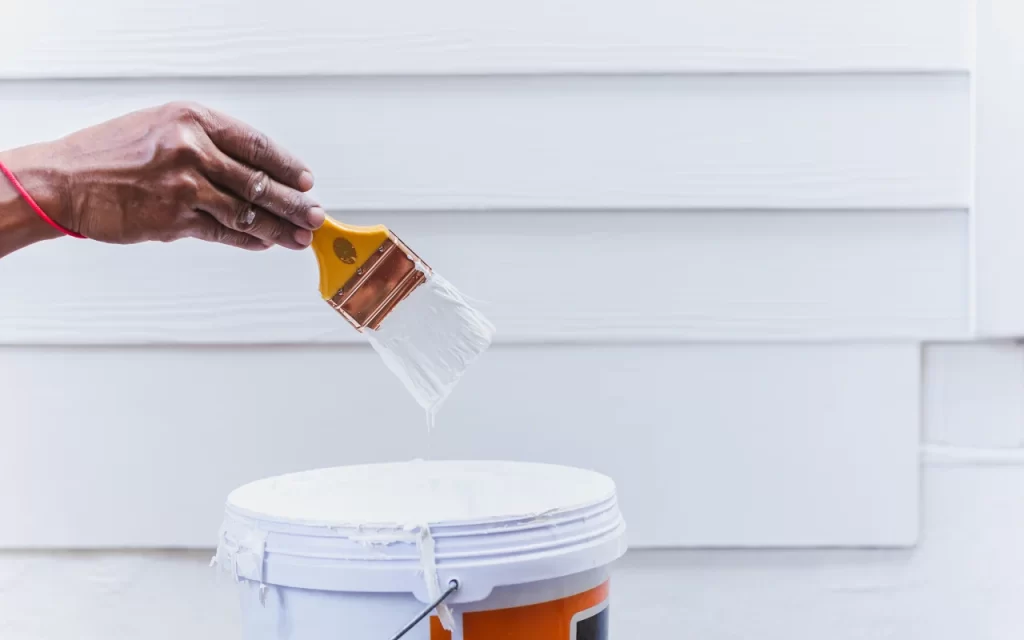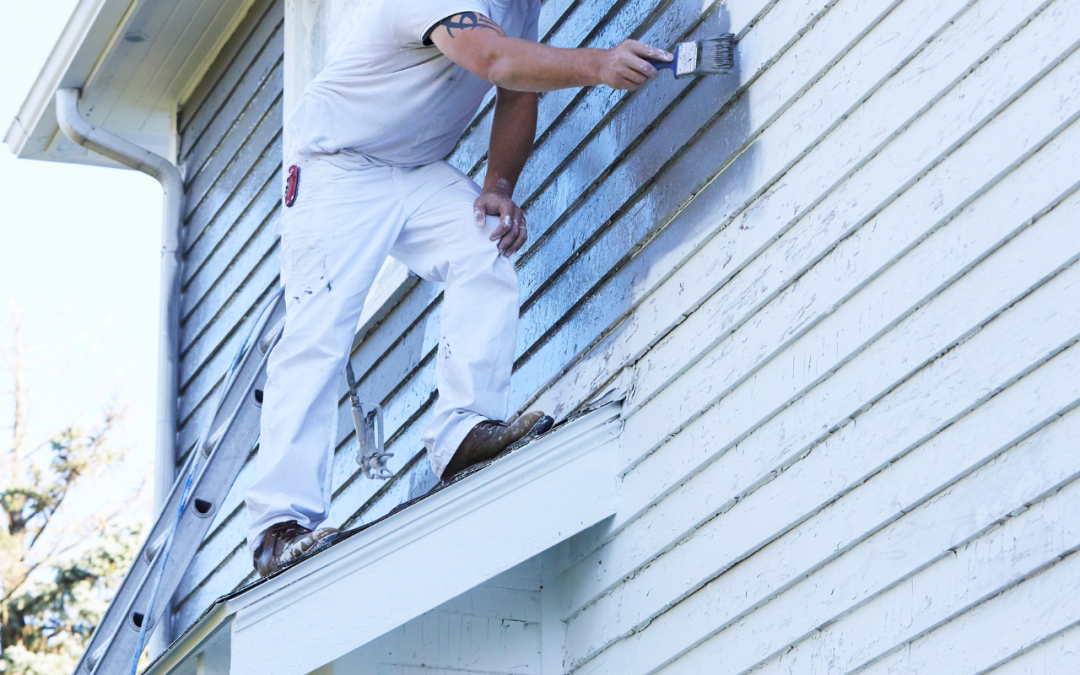Painting the exterior of your home can be a game-changer, refreshing the look, improving curb appeal, and adding value. It’s essential to pick the right paint and prepare for the job for a skilled look that will last. This guide will cover the vital steps, tips, and advice for selecting and applying the best paint for your home’s interior, ensuring a stunning finish.
How to Properly Paint the Exterior of a House?

A well-painted exterior starts with thorough preparation, attention to detail, and the correct choice of paint type. Here’s a step-by-step breakdown of how to tackle the project:
- Choose Your Colour Scheme Wisely: Consider colours matching your home’s architectural style, local environment, and neighbourhood guidelines. Soft neutrals and earth tones are popular, blending well with natural surroundings and offering a timeless appeal. You may also find The Ultimate Guide to Exterior House Colour Combinations helpful for selecting a complementary colour scheme that adds visual harmony and kerb appeal to your home.
- Opt for High-Quality Tools: Brushes, rollers, and sprayers each have their role in painting. Invest in high-quality tools to achieve an even coat and ensure efficiency. For example, a roller can quickly cover large flat surfaces, while brushes are great for detail work around windows and trims.
- Apply primer when needed: Priming the exterior is essential if you’re over a darker shade or switching from oil-based to latex paint. The primer helps the paint adhere better, minimises colour discrepancies, and creates a uniform finish.
- Apply paint in the Right Conditions: Temperature and humidity affect how paint dries. Pick a day between 10°C and 30°C with low humidity and mild temperatures. Never paint in full sunlight because the paint might dry too quickly and leave marks or peel off that you don’t want.
- Use Multiple Coats for Lasting Colour: While a single coat might seem quicker, applying two coats is often necessary for a consistent finish and better protection. Wait to put on the next coat until the last one is dry.
How Do I Prepare My Exterior House for Painting?
Preparation is the foundation of any successful residential painting project. Because you prepared the surface correctly, the paint job will last longer and look better. Here are the main steps to follow:
- Clean the Surface: Dirt, dust, and mildew can prevent paint from adhering correctly. Use a pressure washer to clean the exterior surfaces thoroughly, or wash them manually with soapy water and a brush for more delicate areas.
- Repair Any Damage: Cracks, holes, and peeling paint should be repaired before you begin painting. If the surface isn’t prepared properly, it can lead to paint bubbling on your walls. Check out our guide on What Causes Paint Bubbling on Walls & How to Fix It to learn more about preventing and fixing this issue.
- Sand and Scrape Old Paint: Old paint that’s chipping or peeling can affect the adhesion of the new coat. Use a scraper and sandpaper to remove loose paint and smooth out rough surfaces.
- Protect Surrounding Areas: To avoid painting surfaces that shouldn’t be painted, cover windows, trim, and any adjacent areas with painter’s tape or plastic sheeting. This step keeps things tidy and helps create clean lines around the edges.
- Prime the surface (if needed): Priming helps create an even base, especially if your walls are porous or if you’re switching from a dark colour to a light one. This extra step will significantly affect your paint job’s durability and overall look.
What Paint is Best for the Exterior of the House?
Picking the right paint for the inside of your home is essential for how it looks and lasts. Paint outside a building must withstand bad weather, UV light, and humidity. Here’s a guide to help you select the best type of paint for your project:
- Latex Paint for Flexibility and Durability: Latex-based paints are highly recommended for exteriors due to their flexibility, which helps prevent cracking. They’re easier to clean, have a lower odour, and are generally more eco-friendly than oil-based paints.
- Oil-Based Paint for a Smooth Finish: While less commonly used today, oil-based paints can offer a beautiful, smooth finish and are ideal for primed wood surfaces. However, they have a longer drying time and emit more pungent odours. Additionally, oil-based paint may require mineral spirits or other solvents for cleaning, which can be inconvenient.
- Consider the Finish: The finish affects the paint’s appearance and durability. Here’s the breakdown:
- Flat/Matte: Ideal for hiding imperfections but less resistant to dirt and stains. Great for older homes with less-than-perfect exteriors.
- Satin/Eggshell: It has a slight sheen and doesn’t show dirt or grime, which makes it an excellent choice for exterior walls.
- Semi-Gloss and Gloss: These finishes are great for trims, doors, and windows because they last a long time and are easy to clean. They highlight architectural details but can show imperfections on larger surfaces.
- Weather and UV Protection: Look for exterior paints with added UV protection and water resistance. UV rays can fade colours over time, while moisture can cause paint to peel and mould to develop. High-quality exterior paint options are designed to resist both, keeping your home looking fresh for years.
If you’re looking for an expert opinion or high-quality paint options that can withstand Australia’s weather, explore what Stretch Paints offers. We provide a wide range of paints perfect for residential painting projects, making it easier to ensure your exterior painting project is done right the first time.

Additional Tips
Choosing the best local house painters for quality results is essential if you seek a professional to handle your project. Regional experts have valuable experience with climate conditions and materials that work best for homes in your area.
Another popular choice is to explore modern colour options, such as Why Grey House Paint is the Best Choice for Modern Exterior. Grey offers a stylish, contemporary appearance that blends well with various architectural styles and surroundings, making it an attractive choice for homeowners looking to refresh their home’s decor.
Final Thoughts on Choosing the Right Paint for Your Home’s Exterior
Painting the exterior of your home is a big commitment but well worth the effort when done right. You can give your home a beautiful and lasting finish with thorough preparation, careful paint selection, and proper application techniques. Each step—from cleaning and sanding to choosing the paint and colour—is vital in ensuring that the final result meets your expectations.
Whether you want to boost kerb appeal, enhance your home’s value, or simply refresh its look, investing in high-quality paint and doing it correctly will pay off in the long run. And if you’re looking for professional help, Strata Painting Services can provide expert painting solutions tailored to your specific needs, ensuring your property looks its best.
For further assistance or to find high-quality products that can withstand the Australian climate, contact us at Stretch Paints. With our wide selection of paints, you can be sure your job will be done right from start to finish.



Recent Comments